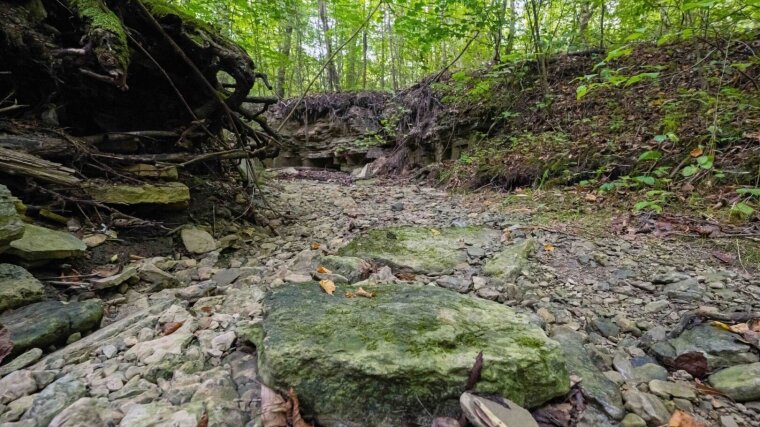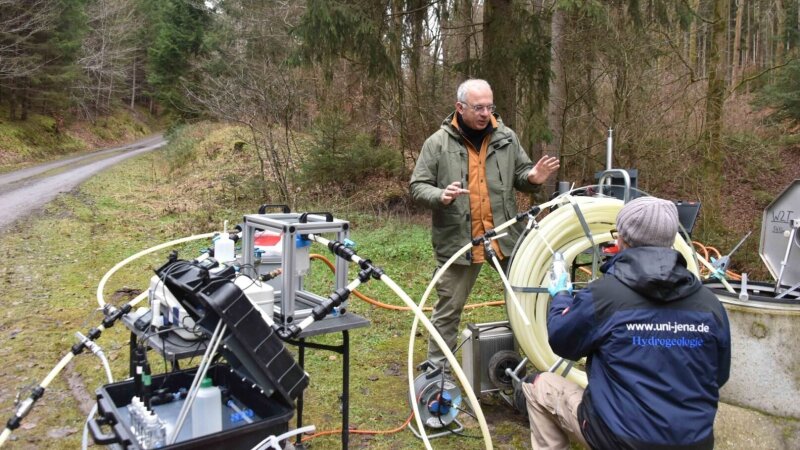
In commercials, seemingly inexhaustible supplies of crystal-clear groundwater gush from springs in idyllic mountain landscapes. But in reality, it is often only a few metres beneath our feet and anything but inexhaustible. What exactly is groundwater? Where does it come from? And how can we stop it running out anytime soon? The hydrogeologist and spokesperson for the Thuringian Climate Council, Prof. Kai Uwe Totsche, provides some answers in our interview.
Interview by Sebastian Hollstein
We are coming off the back of a drought summer, and many more are likely to come – how is climate change affecting our groundwater?
On the one hand, we can see that groundwater levels are falling – very clearly in some cases. This isn’t just something that happened last year – the losses occurring in many parts of the world have increased over the past fifteen years. On the other hand, we are observing changes in the properties of our groundwater, which affects the quality. For example, there has been a rise in water temperature, which is both worrying and astonishing. It is worrying because this speeds up various processes, and astonishing because the surrounding rock must have also been heated up, which usually takes a long time due to the aquifers thermal capacity. This is an unmistakeable sign that climate change has arrived underground. At our measuring stations, we have observed that this warming process is also accompanied by a change in the biogeochemistry of our groundwater. The higher the temperature of our groundwater, the more soluble substances it can contain. This ultimately makes it more difficult – and therefore more expensive – to treat our drinking water.
What actually is groundwater?
Groundwater is the water found in the interconnected void space in the bedrock. On the one hand, it includes deep waters that are primarily the product of geochemical processes. These can be millions of years old and have hardly been used by humans, but this will presumably change in the future.
On the other hand, it is water that comes from precipitation that infiltrates the soil and percolates further down. Depending on the depth and the properties of soil and bedrock, it can take anywhere between a few days and several decades for the percolating water to reach a rock formation that prevents further seepage. This water gathers in the overlying rock – this is known as an »aquifer«. It’s worth emphasizing that groundwater isn’t just »water in rock«; groundwater systems provide habitats that harbour a tremendous biological diversity that is organized into complex food webs. Groundwater systems are ecosystems!
Ideally, the impurities contained in the percolating water are filtered out, transformed, or even broken down on the way through soil and the deeper layers of the Earth’s crust. However, a large amount of the infiltrating precipitation never reaches the groundwater, but is stored near the surface in the soils, where it is available to plant roots or is released back into the atmosphere through evapotranspiration.
In which areas do we rely on groundwater?
Noteworthy, around two-thirds of our drinking water comes from groundwater – and this figure is on the rise. In our latitudes, it is usually pumped out of sedimentary or fractured rock, treated, and supplied to households or the beverage industry. It is also essential for irrigation in agriculture, fruit production, and horticulture with increasing demands due to climate change. Moreover, groundwater has industrial applications as process water – both in residential areas, and, notably, is used to extinguish forest fires. As it feeds our rivers, it also plays an important role for fisheries and inland waterways.
Apart from lower amounts of precipitation, what else is having an adverse impact on groundwater formation?
Land use is a key factor in groundwater formation and quality. Of course, soil sealing plays an important role here, as it makes it difficult or even impossible for precipitation to infiltrate into the soil. But even in places that aren’t completely paved over with concrete, water can’t always seep away as it should. If, for example, the soil becomes too compacted due to high pressure – »surcharge« – the water doesn’t seep away slowly, but preferentially and more quickly in large pores and cracks. As a result, the filter function fails and alien substances enter the subsurface were these don’t belong to, such as pesticides.
To break down such pollutant inputs, the numerous life forms and functions of the groundwater ecosystem are essential. I’ve been researching this at the »AquaDiva« collaborative research centre for the past more than ten years alongside my colleagues Prof. Kirsten Küsel and Prof. Susan Trumbore. We’re trying to find out how surface ecosystems and groundwater ecosystems are connected and how land use on the surface influences the biodiversity and functions of the subsurface. The “clean-up” capacity of the groundwater ecosystems and overlying layers is heavily dependent on the vast variety of organisms inhabiting the subsurface. That’s why we are investing a lot of time and effort into shedding more light on this terra incognita.
How can we change our land use to aid the formation of groundwater and improve its quality?
In general, we should see both, groundwater recharge and groundwater quality, as important goals of land use. There are many ways to encourage this. First of all, we should stop sealing ground and unseal more areas. We then have to create land management practices that keep water in the area by restoring and increasing the seepage and cleaning capacity again and significantly slowing down the run-off via watercourses.
There are many ways of doing this – in residential areas, in agriculture, and in forests. For example, a deciduous forest ecosystem provides much more recharge than a coniferous forest. At the same time, we can influence condensation processes such as dew formation, but also evaporation or transpiration – and not only through vegetation. By managing our use of land, we can ensure that more water infiltrates into the soil instead of being released back into the atmosphere.
What other points of attack are there, for example in agriculture?
We need more areas where water isn’t seen as a nuisance, but is given time to seep away. For example, large districts of agricultural land were drained during land consolidation projects in the 20th century, so that the land could be cultivated without the risk of flooding. In addition, the course of running waters has been straightened, leading to a gradual increase in their flow velocity and causing the proximate soils in the vicinity to dry out. However, we should aim for keeping the “water in the catchment” – especially in the subsurface environment. So, we have to undo our interventions. Many of the measures involved would also benefit agriculture and help us adapt to the effects of climate change.
How so?
Soil moisture is an important prerequisite for the formation of humus and is therefore essential for fertile soils. When humus is formed, CO2 is sequestered in the soil in the form of humified organic substances. Increasing the humus pool of the subsurface is thus an efficient way to reduce CO2 in the atmosphere. We’re investigating some of the fundamental aspects of this process in my »MAD Soil« research group. We’re focusing on the smallest structural elements in soils – »microaggregates« – which range in size from a few nanometres to 250 micrometres and are incredibly effective in binding organic carbon in the form of mineral-organic associations. Among other things, we’ve shown that biogenic polymers play a very important role as adhesives and stabilizers for the formation and stability of these »soil building blocks«.
The conventional agricultural use of land around the world has led to a significant loss of humus from soil, which has greatly accelerated the greenhouse process. Agriculture must therefore set itself the goal of significantly increasing the soil humus content again.
How can you, as a scientist and spokesperson for the Thuringian Climate Council, encourage and support measures to increase groundwater formation?
Among other things, we’re helping to develop new management systems. One of the key areas is urban water management, where it’s important to collect precipitation on sealed surfaces. We’re working closely with partners from forestry and water management, providing information as to how landscapes can be redesigned. For example, we’re using digital methods to observe and model the “hydromorphy” and its changes due to human activity – not only as the basis for developing management strategies for groundwater catchment areas, but also to devise specific measures in the fields of forestry, agriculture, and urban water management. As a spokesperson for the Thuringian Climate Council, I’m also taking the topic from the scientific field into politics and the public sphere, so that more people are aware of the issues and willing to tackle them.
Prof. Dr Kai Uwe Totsche (pictured left) and environmental protection engineer Heiko Minkmar take groundwater samples from a research measuring point in the forested groundwater recharge area near Hummelshain.
Image: Anne Günther (University of Jena)